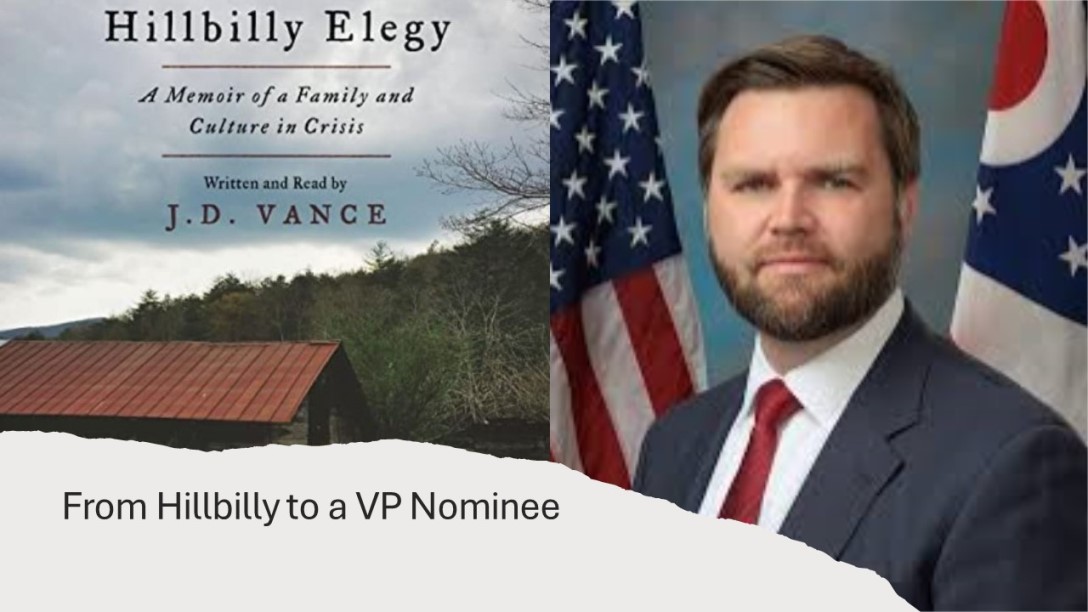Translating deep thinking into common sense
J D Vance and the Primacy of Personal Responsibility

By Walter Donway
July 17, 2024
SUBSCRIBE TO SAVVY STREET (It's Free)
Author, U.S. Marines veteran, and Yale Law School graduate, the Ohio Republican Senator James David Vance, is now Donald Trump’s VP nominee. If Trump wins big in November, Vance, 39, could well be an unchallenged frontrunner for 2028.
Early on, as Vance tells it, he “fell for the media” attacks on Trump, but when he watched Trump in action as president, he came to believe Trump was a first-rate American president. Trump endorsed Vance for his victorious 2022 run for Senator.
Even while Vance was weighing the Senate run, he sat down in 2021 for an interview with Breitbart News, which began with a discussion of “Critical Race Theory.” Vance said:
“It’s like original sin.” If you’re a white person, whether you came from a really rich family or a really poor family, you all share in the same fundamental original sin of the country… [It is] fundamentally racist in a way that deprives people of dignity.”
He said: “Disdain for America is the political glue unifying disparate components of the Democrats’ coalition. Critical race theory, wokeness, whatever term we want to [use] … helps hold the Democratic Party together. What unites Democrats, Jeff Bezos, a black working-class person from South Carolina, and a woke urban millennial single person who doesn’t have kids in New York City? …There’s no shared sense of history. They have very different lives, but the one thing that they can see to unify around is that America is a bad country. We don’t really owe anything to this sort of nation that we came from.”
With Vance’s nomination as VP, the book that first propelled him to national fame, Hillbilly Elegy: A Memoir of a Family and Culture in Crisis, a bestseller when it was published in 2018, has jumped to #1 on the Amazon bestseller list. It presents a profoundly different vision of the American Dream than does Critical Race Theory.
So, what is a hillbilly? And does anyone care?
Occasionally, from a silent, insular sector of American life — often a sector hidden behind stereotype and myth — comes a writer to tell its story. Such a man was Ralph Ellison, in The Invisible Man (Random House, 1952), writing about the plight of urban American blacks in the aftermath of World War II. Surely, another was John Steinbeck, in The Grapes of Wrath (1939), although more as an observer than a participant.
J.D. Vance, in Hillbilly Elegy (HarperCollins, 2016), comes to us out of the mute, insular, and too-seldom-escaped world of the American hillbilly. He comes with scars and trauma, psychologically defensive and ready to lash out, but also with intense love and loyalty to a way of life as definingly American as any — perhaps more than most.
That way of life in America has changed, but for the hillbillies, the change has ranged from disappointing to catastrophic. As J.D. says, again and again, he was exceedingly lucky to escape the enveloping hillbilly tragedy and experience the American Dream. He urges upon us the lessons of sociology, psychology, morality, and government policy that might make such salvation more common.
The Hills and History
If there is a workable definition of “hillbilly,” it is one born in the Appalachian or Ozark mountain regions. Another definition, though, is historic and ethnic. Arriving in America a half-century or more before the Revolutionary War, a vast immigration from Ulster, Ireland, settled the American South.
Oddly, this was a twice-uprooted people. The Irish of Ulster earlier had come from Scotland and England, driven forth by the “enclosure” movement. Those who arrived in the American South early and in great numbers were the Scots-Irish. No settlers more surely defined the character of the region and era.
See the review at:
Hillbilly Elegy and the Primacy of Personal Responsibility.








